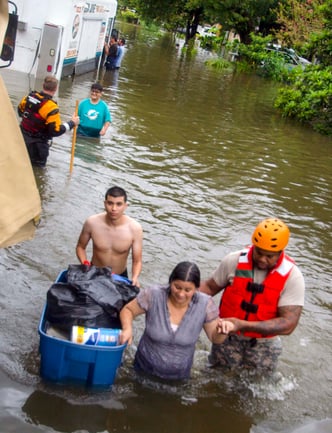
Hurricane Harvey: Lessons Fundraisers Can Learn Right Now
 When natural disasters hit, there’s a familiar chain of events. Discourse often turns to whether the public had adequate notice; how responsive local and state governments are; and the robustness of the response from the federal government. Charities and their legions of dedicated volunteers will mobilize to help with immediate and long-term needs. Fundraisers will go into fire drill mode. And so it’s going with Hurricane Harvey.
When natural disasters hit, there’s a familiar chain of events. Discourse often turns to whether the public had adequate notice; how responsive local and state governments are; and the robustness of the response from the federal government. Charities and their legions of dedicated volunteers will mobilize to help with immediate and long-term needs. Fundraisers will go into fire drill mode. And so it’s going with Hurricane Harvey.
But Harvey is different. Harvey is epic.
A year of rain in just a few days (and more expected as of this writing). Houston’s City Hall is flooded. Hospitals are evacuated. Runways have become raging rivers. Catastrophic flooding is affecting the entire economic spectrum. Mother Nature, tragically, is the great equalizer. Stripped of all of the social mores and philosophical discussions, a city like Houston becomes, quite literally, an island in wait.
Harvey is also different because the call from local and state officials has been to actively solicit residents and citizens with boats or high-water vehicles to help save those who are trapped. Everyone is being asked to do their part. There is active admission that no one entity — government nor charity — can help save lives alone.
Another new dimension in this particular disaster is social media. When Katrina hit, cell phones and social media weren’t used as actively. Sandy was one of the first natural disasters to quickly convey to the world exactly what was happening. I remember in 1992, Hurricane Andrew heavily damaged my childhood home in Miami. And I didn’t know anything about it for two weeks, until I was finally able to reach my parents on a landline. Social media is also one of the great equalizers and lessons of Harvey. The 911 system is swamped. The victims of Harvey are asking to be rescued through Facebook and Instagram.
As fundraisers, we employ strategies to get donors to do their part. But we have to ask ourselves: Why does it take an active, unfolding disaster — or the aftermath of a catastrophe — to tap into the swell of donor motivation?
Psychology helps explain this a little. The bystander effect refers to the phenomenon where the more people who witness distress, the less likely they are to help. In other words, there appears to be a diffusion of responsibility: So many people are witnessing something bad, so someone else will probably help and do something good. It doesn’t have to be me.
And that’s when we, as fundraisers, must respond with: Yes, it has to be you.
It’s our job to rouse donors, whether there’s a terrible disaster or not. We have to light the fires of motivation in donors and keep them burning brightly all year, not just when something unexpected and out of the ordinary, like an epic hurricane, summons donors to attention.
We can keep our donors motivated through solid fundraising and use of the principles that we know work:
- Powerful storytelling. The images and stories coming out of Harvey are a moving reminder of the palpable catastrophe unfolding. People and pets stranded. Lives in danger. The immense property damage is a byproduct when lives are at stake. Fundraising storytelling provides urgency through context and perspective. Let the stories do their work.
- Donor-as-hero approach. If you treat your donors right all year long, they’ll be ready to spring into action when you ask. Being treated like a hero deepens their loyalty. And it ensures that your donor won’t become a bystander. Don’t allow it. Charge the donor with action. She or he can do something real and impactful, and they must. Right now. There is an impact to not doing something. Let them know.
- A specific offer. Donors want their gifts to do something. Seems obvious, but ask yourself what you’re actually asking donors for. Make your ask as specific as possible.
- Report back. Don’t forget that donors want to be thanked, of course, but they also want to know that their gift didn’t fall into a black hole. Remember the storytelling that moved donors so powerfully, and use it to move them again with the impact they made.
As I write this, I’m watching video of Texans helping Texans. Officials and first responders and ordinary residents alike. Quickly and efficiently pulling people from roofs and windows, past the dirty floodwaters swirling around their waists. Helping the elderly. Throwing pets around their necks. Carrying mothers. Carrying children.
They are simply and quietly doing their jobs as neighbors, as citizens, and remembering that it’s our common humanity which unites us all. As fundraisers, we must remind donors of that, too. Not just during times of historic, crushing disasters — but every chance we can.
Photo courtesy of U.S. Department of Defense. Photo usage does not imply or constitute DOD endorsement.
